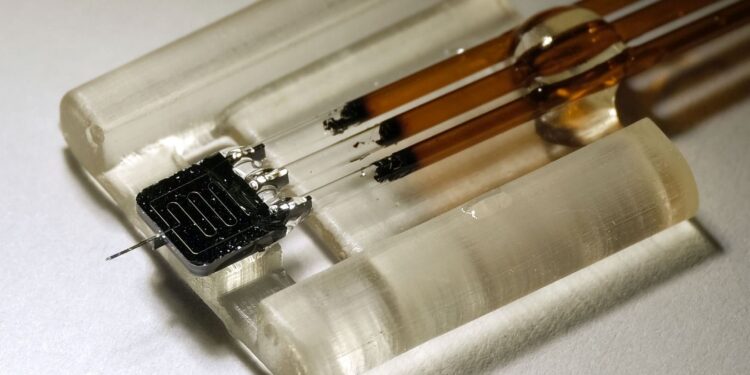The nanodialysis device manufactured and packaged. Credit: The Grainger College of Engineering at the University of Illinois at Urbana-Champaign
Long-standing challenges in biomedical research, such as monitoring brain chemistry and tracking the spread of drugs in the body, require much smaller and more precise sensors. A new nanoscale sensor capable of monitoring areas 1,000 times smaller than current technology and tracking subtle changes in the chemical content of biological tissues with sub-second resolution, far outperforming standard technologies.
The device, developed by researchers at the University of Illinois at Urbana-Champaign, is silicon-based and takes advantage of techniques developed for manufacturing microelectronic products. The device’s small size allows it to collect chemical content with near 100% efficiency from highly localized regions of tissue in a fraction of a second. The capabilities of this new nanodialysis device are reported in the journal ACS Nano.
“With our nanodialysis device, we take an established technique and push it to a new extreme, making biomedical research problems that were previously impossible completely feasible now,” said Yurii Vlasov, professor of electrical and computer engineering at the University of I. -responsible for the study. “Additionally, since our devices are fabricated on silicon using microelectronic fabrication techniques, they can be manufactured and deployed at scale.”
From micro-to nanodialysis
Nanodialysis is based on a technique called microdialysis in which a probe with a thin membrane is inserted into biological tissue. The chemicals pass through the membrane and end up in a fluid that is pumped for analysis. The ability to directly collect tissue samples has had a major impact in fields such as neuroscience, pharmacology and dermatology.
Traditional microdialysis, however, has limitations. The probes sample over a few square millimeters, so they can only measure the average composition over relatively large regions of tissue. The large size also results in some degree of tissue damage when the probe is inserted, which may skew the analysis results. Finally, the fluid pumped through the probe flows at a relatively high rate, which impacts the efficiency and accuracy with which chemical concentrations can be read.
“Many problems with traditional microdialysis can be solved by using a much smaller device,” Vlasov said. “Reducing the size of nanodialysis means more precision, less damage from tissue placement, chemical mapping of tissue with higher spatial resolution and much faster readout time allowing a more detailed picture of changes in chemistry fabrics.”
Slow and steady
The most important feature of nanodialysis is the ultra-slow flow of fluid pumped through the probe. By making the flow rate 1,000 times slower than traditional microdialysis, the device captures the chemical composition of tissue collected from an area 1,000 times smaller than traditional techniques while maintaining 100% efficiency.
“By significantly decreasing the flow rate, this allows the chemicals delivered into the probe to match the outside concentrations in the tissue,” Vlasov explained. “Imagine adding dye to a pipe with flowing water. If the flow is too fast, the dye will dilute to concentrations that are hard to detect. To avoid dilution, you need to turn the water down almost all the way. “
Silicon manufacturing and production
Standard microdialysis devices are constructed using glass probes and polymer membranes, making them difficult to miniaturize. To build devices suitable for nanodialysis, researchers used techniques developed for electronic chip manufacturing to create a silicon-based device.
“In addition to allowing us to shrink in size, silicon technology makes devices cheaper,” Vlasov said. “By spending time and effort developing a manufacturing process to build our nanodevices on silicon, it is now very simple to manufacture them on an industrial scale at an incredibly low cost.”
Rashid Bashir, professor of bioengineering at the University of I. and dean of the Grainger College of Engineering, co-led the project.
More information:
Insu Park et al, Highly localized chemical sampling at sub-second temporal resolution enabled with a silicon nanodialysis platform at flow rates of nanoliters per minute, ACS Nano (2024). DOI: 10.1021/acsnano.3c09776
Provided by the University of Illinois Grainger College of Engineering
Quote: Research team develops nanoscale device for brain chemistry analysis (February 21, 2024) retrieved February 21, 2024 from
This document is subject to copyright. Apart from fair use for private study or research purposes, no part may be reproduced without written permission. The content is provided for information only.



